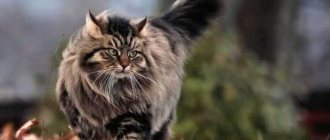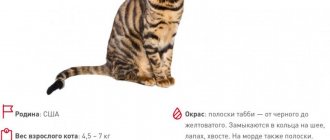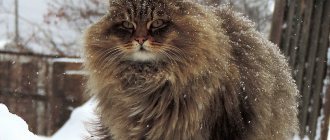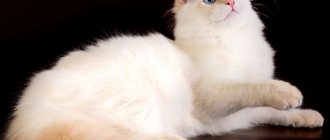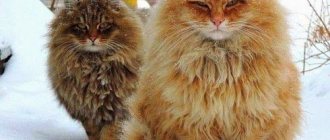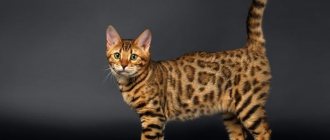Review author: “ZooVita”
Among the 36 breeds recognized by the International Federation of Cat Fanciers, the Russian Siberian cat occupies a worthy place.
Noble appearance, generous character, courage, friendliness - these are the qualities of the breed that attract cat lovers.
History of the origin of the Siberian cat breed
The origin of the Siberian differs from most known breeds. Many of the currently existing cat species were bred after lengthy breeding work. Siberian, according to experts, is the result of natural selection. The cat was brought to the territory of Siberia by pioneers in the 17th-18th centuries.
No one was specifically involved in selection, and felinologists (specialists who study cats) believe that the formation of the breed was significantly influenced by the crossing of local and Persian cats.
Interesting facts about the Siberian cat breed
At the end of the 20th century, the current standard was approved, which distinguishes one breed from another. Existing canons of breed interpretation include taking into account the following factors:
- the weight of an elite representative of the species;
- height at withers;
- head shape;
- eye color and shape;
- tail;
- wool;
- general appearance of the physique.
Breed standards Siberian cat
According to the standard descriptions of the Siberian cat, its data should be as follows:
- The body weight of an adult animal should reach ten kg.
- Height at the withers is forty centimeters for a male, ten centimeters less for a cat.
- The head is large. It allows the presence of tufts on the ears, which gives the Siberian a resemblance to its wild relative – the lynx.
- The eyes are oval, slightly slanted, and the color is either greenish or yellow.
- Fluffy and moderately long tail.
- A purebred cat must have two undercoats and an outer coat that is impermeable to water. In summer, Siberians look like short-haired breeds; only the tail remains fluffy. With the onset of cold weather, a cute collar appears, and the hind legs are decorated with fluffy “pants.” Well, the tail fluffs up even more.
Appearance
The Siberian cat breed can be described as follows: they have a truly royal appearance and majestic appearance.
Their thick fur makes them look impressive. The strong, large body harmonizes perfectly with the sweet, majestic face.
Siberians have a proportional body:
- A dense body of medium length, a powerful back and a wide chest combine perfectly with a small neck on which an elegant frill flaunts;
- The head is in the form of a trapezoid, the muzzle has smooth outlines. Developed, low-set cheekbones and dense cheeks;
- The ears are medium in size, wide at the base and rounded at the tips. The earlobe has long fur;
- The eyes are medium-sized, oval-shaped, widely spaced. Eye color can be green or yellow;
- Paws are powerful, muscular, of medium length;
- The tail is wide at the base, narrowed and rounded towards the tip;
- The coat is soft, dense undercoat of fine texture. In summer, Siberians have shorter fur than in winter. By the cold season, they develop a rich, thick collar, and their hind legs become more fluffy;
- The weight of males can reach twelve kilograms, females - seven kilograms;
- Height from 28 to 40 centimeters;
- Life expectancy is from 15 to 20 years.
Diseases of the Siberian cat breed
By nature, cats of the Siberian breed have excellent health. Experts believe that only a person with an incorrectly formulated diet and poor care can disrupt the animal’s good health. This is partly true, but at the same time cats can suffer from:
- urolithiasis;
- shortness of breath, lethargy and cough in old age.
In addition, prolonged loneliness can develop extreme excitability and activity in a cat.
Hair getting into the stomach of a pet also causes unpleasant consequences. Typically, a cat gets rid of hairballs using the gag reflex. In some cases, you should help the purr - give a tablespoon of sunflower oil. A teaspoon will be enough for a kitten.
In case of urolithiasis or senile ailments, you should contact a veterinarian.
Color of the Siberian cat breed
The photo of Siberian cats shows how different colors breeders do not tempt potential buyers! Among the most popular we note the following:
- tricolor;
- ginger;
- brick;
- golden and silver;
- tortoiseshell;
- two-color;
- the coat has a blue tint, and the nose and paws are gray.
There are several other colors, for example, the gray Siberian cat and the Neva masquerade, but the federation of cat lovers has not yet approved them as a standard.
The color of a kitten's coat is determined by the influence of parental melanin. In nature, there are two types of this substance - black and red. The interaction of colors is the basis for the formation of all existing colors. The exception is the white color of animals.
Health and life expectancy
Siberian masquerade cats live about 13–15 years. Those with a stable immune system rarely get sick. If you provide your pet with adequate nutrition and properly care for it, its life expectancy can increase by another 3-5 years.
The only disease that is more common in Neva masquerade cats is hypertrophic cardiomyopathy. This is a pathology in which the walls of the left ventricle thicken, resulting in heart failure.
Important! The danger lies in the fact that cardiomyopathy does not manifest itself for a long time. The disease gradually progresses and can lead to sudden death.
Features of behavior of the Siberian cat breed
The character of the Siberian cat is changeable. Siberian beauties love to play with small children, but only if they themselves want to. The lack of reaction to human affection means that the animal is not in a good mood, it is better to leave it alone.
Like all cats, they love to observe everything that happens around them from above. They often climb onto cabinets, shelves, and shelves. Don't be surprised if you find your pet on the chandelier!
It gives the owners undisguised pleasure to watch the amusing poses of their pet.
Important! A cat that lives in a city apartment must be taken for a walk (at least once a week).
Buying a kitten
Choosing a kitten is a responsible step, because you are purchasing not just an animal, but a new family member who will become your faithful friend for the next two decades.
A Siberian pet will definitely become a member of your family, so you should take its choice seriously
Some tips:
- Prepare theoretically in advance: try to learn as much as possible about the characteristics of the Siberian breed and the rules for its maintenance.
- “Try on” the cat to your home conditions: think about where he will eat, sleep, go to the toilet, and play.
- Be sure to come to a consensus with all your family on the issue of purchasing a cat - the animal will feel comfortable if it does not bother anyone.
- In a timely manner, select everything necessary for the kitten: bowls for food and water, a tray, a scratching post, combs and toys, stock up on food.
And of course, the most important thing is to decide what kind of kitten, where and why you want to buy. As has already been said, there is nothing wrong with even bringing a cat into your home from the street, much less buying it at a bird market or borrowing it from friends. There are a lot of options - but none of them guarantee that a miracle will happen and thus a truly purebred animal will appear in your home. There is little chance that it will be at least healthy and with a stable nervous system.
A kitten from the street or from friends may differ from the breed standards, even if it looks very similar to a Siberian
How to choose
If you want guarantees, choose a reliable breeder first, and only then a kitten. The choice of nurseries that breed the Siberian breed today is quite large, and they all value their reputation. They will help you choose a child based on his expected prospects and your ambitions.
Remember that a show-class animal can cost several times more than just a pet, which will delight you no less. But if you plan to participate in exhibitions and breeding, then it is better to purchase an older kitten - its qualities can be assessed more accurately. In all other cases, you need to choose a baby no younger than two and a half months - by this age he must be vaccinated and accustomed to at least the basic rules of independent living in a new home.
Do not buy a kitten that is too small - let him grow up a little next to his mother, who will teach the basic rules of cat behavior in the house
If possible, talk to the baby's parents - their appearance and behavior can outline the characteristics of the pet you choose. Listen to the breeder's recommendations - this will help you properly raise a healthy and beautiful animal.
Conditions for keeping the Siberian cat
Maintaining a furry creature will not require much effort or time. Siberian purrs quickly get used to the tray and are neat and clean. Since cats have rather hard hair, it does not form tangles and does not need frequent brushing. It is enough to brush your fluffy beauty once a week. True, during the spring and autumn molting period the procedure will have to be carried out more often.
The Siberian cat does not like water and should be washed only after a walk in nature. During the water procedure, it is necessary to tightly close the ears with cotton wool, and the water temperature should be in the range of 38-39 degrees.
Considering the strength of Siberians, it is better to wash a cat together. After the “bath”, you need to thoroughly wipe your pet and let it dry in a warm room where there are no drafts.
Important! Regular cleaning of the ears is necessary, and the corners of the eyes should be wiped with a damp cotton swab.
Care for a pet
A very beautiful white cat is not too picky. If you follow all the rules, the animal will become the main decoration of your home, since a red or white animal has strong and thick hair, and there will be no problems with caring for it. The pet's fur does not fall out in clumps when shedding and does not gather in tangles. But you need to take care of her. It is imperative to accustom your cat to a furminator (comb-trimmer for combing out the undercoat) from an early age.
It must be remembered that a lot of dead hair will end up in the pet’s stomach while washing with the tongue. You can help your pet cope with unnecessary supplements by introducing grass and oats into the menu.
When choosing an animal, you need to find out about its vaccination, focus on the availability of health certificates and check that all documents are filled out correctly
You should not bathe your pet too often. This procedure is performed once every 10 months. If the cat regularly attends exhibitions, bathing is carried out once a month. But it is necessary to accustom your cat to bath procedures from a young age. It would be a good idea to purchase a scratching post.
Nutrition of the Siberian cat
Cats are not picky when it comes to food, but having an excellent appetite and knowing the weaknesses of their owners, they abuse this and beg from them for various delicacies.
Recommended diet:
- raw lean beef (need to be doused with boiling water);
- poultry meat;
- boiled sea fish;
- dairy products (cottage cheese, cheese, fermented baked milk).
Kittens, nursing mothers and cats expecting offspring benefit from low-fat cream and goat's milk.
As supplements, you can give boiled egg yolk and a minimum amount of dry food of the highest quality.
Many cat lovers accustom their pets to rice, buckwheat and oatmeal porridge.
Interesting features of the Siberian cat breed
- The first mention of Siberian cats dates back to the 16th century. But then they were called Bukhara cats.
- Representatives of this breed are excellent hunters. Having a Siberian cat in the house, you can forget about the existence of any rodents.
- Cats are wonderful fathers and help their “wives” raise their children.
- They are distinguished by monogamous relationships. Cats enter into a “love” relationship with only one cat.
- Siberians are independent and independent creatures. These kinds of pets are suitable for people who do not have the opportunity to devote a lot of time to their pets. Without its owners, the cat will not be bored, but will find something to do to its liking.
- Tortoiseshell males, as a rule, do not give birth to offspring.
- Siberian cats get along well with small children and dogs.
- They recognize only one owner; the rest of the household, at best, are considered only their equals.
- They love boiled shrimp and for the sake of this delicacy they can resort to “blackmail”, refusing to eat other foods.
Choosing a kitten
In order to take a little Siberian into your home, it is better to contact breeders who have proven themselves to be excellent. Since unscrupulous sellers can sell outbred animals, taking advantage of the fact that Siberian cats have a variety of colors.
- The best age to adopt a Siberian cat kitten into your home is three to four months.
- At this age, it is possible to raise a child as needed.
- A six-month-old kitten will have to be retrained, since it has already formed certain habits.
- A three-month-old fluffy should be moderately well-fed and show interest in the world around him. He should not try to escape if picked up.
The baby should have a wide chest, strong paws and shiny fur. The seller is obliged to provide information about vaccinations and pedigree. If the kitten does not have documents, then its price will be no more than three thousand rubles.
A Siberian cat with a pedigree can cost from ten to thirty-five thousand rubles. This price range is explained by the rarity of the animal’s color.
